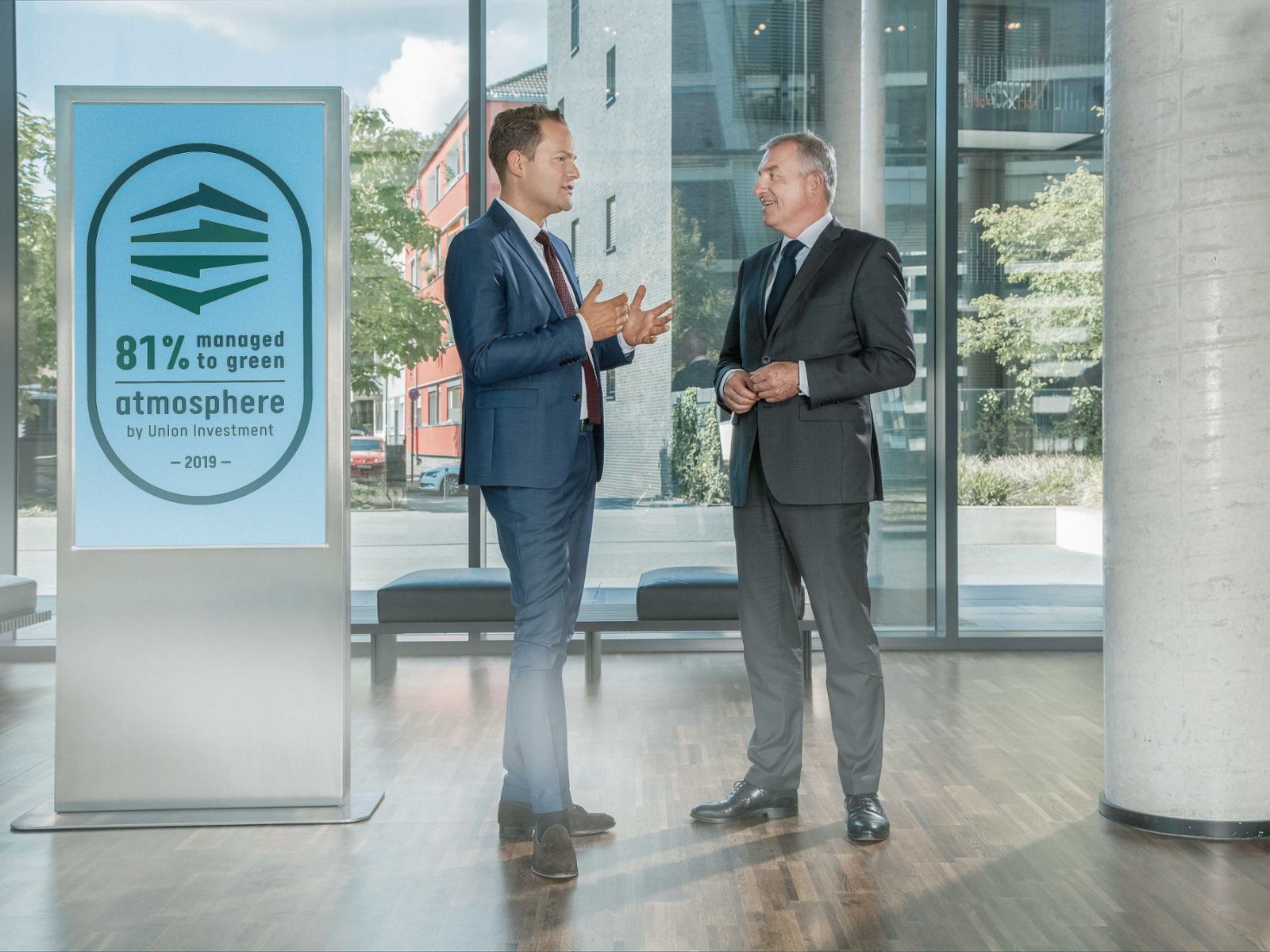In the real estate sector, success has traditionally been measured in terms of financial performance. Does sustainability conflict with that?
Röhrs: Investments in sustainability help a property to retain its value and contribute to long-term competitiveness. That’s why such measures are basically a given for Union Investment. It’s like if a roof is leaking – we don’t ask ourselves whether repairing it will affect returns. Sustainability is up there with all the other tasks involved in developing our existing building stock. It’s the only way we can find the kind of tenants we want for our high-quality spaces.
What impact do the EU’s standards have on portfolio management?
Von Mallinckrodt: Development on this front is not surprising, but the pace of it is. Fortunately, Union Investment already has a good understanding of sustainability. Back in 2018, we set out in our Manage to Green strategy how we intend to make our holdings zero carbon by 2050 at the latest. That is significantly more ambitious than what the EU taxonomy currently requires of us. Taxonomy compliance shouldn’t be confused with zero carbon. However, there is still uncertainty as to what investments make sense in the current situation.
Röhrs: As part of our fiduciary duty, we need clarity about whether it’s better to invest client monies now or later. In the case of UniImmo: Deutschland we’ve decided to actively address the issue rather than playing wait and see.

"Our Manage to Green strategy sets out how we intend to make our holdings zero carbon by 2050 at the latest." Jan von Mallinckrodt Head of Sustainability Union Investment Real Estate GmbH
In October, you classified six retail funds as Article 8. What implications did that have for portfolio management?
Von Mallinckrodt: In terms of processes there was hardly any effort involved, the instruments were already in place. In that respect, switching to Article 8 was only logical – but at the same time it’s just a first important step towards zero carbon. We know we’re facing a long-term mission. Transformation takes time. And we still need innovation in the construction industry to solve the challenges around the existing building stock.
Röhrs: UniImmo: Deutschland has many thousands of investors who came on board before the sustainability framework was in place, but we also want to win over new investors by highlighting the fact that our open-ended real estate fund is a sustainable investment. For both audiences, the message is important that we’re not starting from scratch and are actively managing the necessary transformation process. Switching to Article 8 is a sign of that.
How are you managing the transformation with regard to sustainability requirements?
Von Mallinckrodt: We’re deploying our Sustainable Investment Check, which has been in use since 2009 and covers all the relevant factors. The S in ESG is not yet defined by the taxonomy – BaFin, the German Federal Ministry of Finance and the EU each have rather different ideas. We are therefore following our own set of criteria and focusing on indoor environmental quality, safety, local shopping facilities and social engagement within our properties, to name just a few aspects.
Röhrs: Our properties should make users feel good. For many of our office buildings, the target group are companies with employees and management teams who are very aware of sustainability issues in the workplace. They value things such as accessibility by bicycle and public transport as well as plenty of bicycle parking spaces, showers, changing rooms and also well-lit parking areas that allow people to feel safe.

By 2025, Union Investment plans to implement energy monitoring as part of its Manage to Green strategy in all fund properties.
.png/jcr:content/MicrosoftTeams-image%20(2).png.png)
How are you boosting the portfolio’s sustainability?
Von Mallinckrodt: Quick initial wins can be achieved by picking up obvious problems, such as the heating being on seven days a week when the building is only used for five. In addition, we’re trying to drive forward energy modernisation by installing smart meters and then identifying ways of reducing consumption.
What does that mean in concrete terms?
Von Mallinckrodt: The core element of our Manage to Green strategy is energy monitoring. We want to put that in place across all fund properties by 2025. For us, that means equipping around 80 properties a year with sensors to obtain reliable data. That has already happened in over 100 buildings. At the same time, we’re gradually analysing the entire portfolio, looking at the national and international requirements and establishing what we need to achieve at each property.
Röhrs: Essentially, we want to take our holdings to a higher level. Where there’s a technical solution, we will do the necessary work. If investment to improve sustainability is not considered viable, then some properties may end up being sold.
„Investments in sustainability help a property to retain its value and contribute to long-term competitiveness.“ Thomas Röhrs fund manager, UniImmo:Deutschland, Union Investment

Have you any idea what that proportion will be?
Röhrs: It would be naive to think we can simply sell properties which lack the necessary sustainability potential and replace them with ones that offer perfect energy efficiency. It also wouldn’t make sense. Selling a property just to remove it from our portfolio doesn’t help the environment. Take a hotel in an attractive location, for example. Or a shopping centre with lots of regular customers. These properties don’t lose their relevance just because they fail to meet the latest standards. That’s why we need to take any straightforward technical measures and where that’s not possible, to ask ourselves what the negative impact of the property is on the portfolio. Modernisation might not be an option now, but maybe it could work in five years’ time.
Von Mallinckrodt: The strategy of not relying on new builds is absolutely right. There’s really no such thing as a sustainable new building. You always have to consider the life cycle of a property and the CO2 emissions produced when manufacturing the construction materials.
How do fund managers and sustainability experts work together here?
Röhrs: There’s a constant tradeoff between the recommendations of the sustainability unit and the scope for implementation within individual properties. It’s not really about the costs, because we know there is no alternative to this strategy. Our task as fund managers is to get things moving and agree a roadmap with Asset Management
What role do users and their behaviour play?
Röhrs: Transformation can only succeed as a shared endeavour. The best way to get users on board is with compelling reasons. Sensors enable us to present potential savings in black and white, such as when water consumption data shows that one storey is never used at weekends. This transparency doesn’t go down well with every tenant, though. You have to be committed to sustainability. However, we believe that more and more tenants do have that commitment.
Von Mallinckrodt: Regulations are helping to create a sense of urgency. From the end of 2024, companies will have to publish their CO2 emissions. That will probably help us to get proper insights into our tenants’ consumption patterns, which will enable us to work with occupiers to achieve the necessary transformation of our properties.
Do investors reward sustainability strategies?
Röhrs: There’s been a marked increase in the number of investors for whom sustainable investment is important. Being seen to have a sustainability strategy can therefore definitely lead to higher sales. But as well as winning over new customers, for me it’s just as important to show our existing investors – who didn’t subscribe to the fund on this basis – that we’re serious about the transformation process but also taking a very measured approach. We want to be completely transparent about that.
Von Mallinckrodt: We need customers to accept that our strategy will impact performance in the short term but underpin returns and future-proof their investment over the long term. The responsibility lies with us. We have it in our power to solve this great challenge of the future by taking the right action now.

More than 100 Union Investment fund properties are already equipped with sensor technology.
